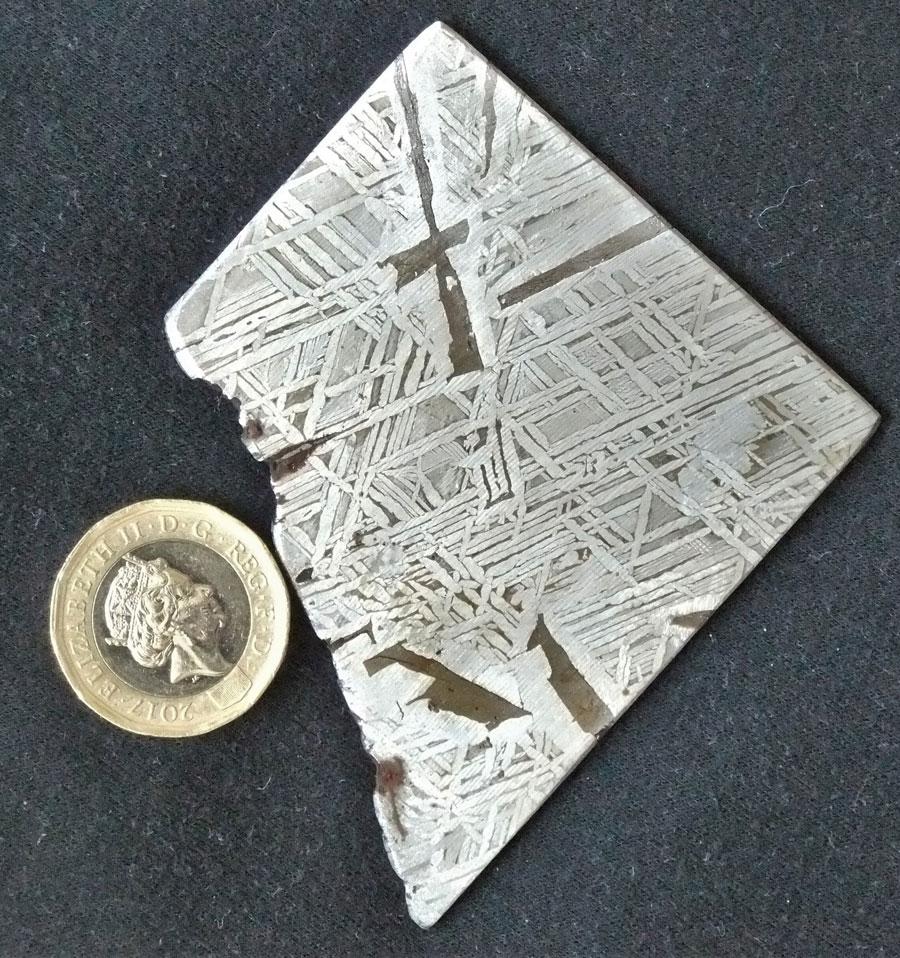Fred Starr recollects… Fallen star
Fred Starr FIMMM reflects on space’s meteorite wonders

The fireball that streaked across Wales, UK, in early 2021, pieces of which landed in the west of England, gave humanity some rare and precious examples of a carbonaceous meteorite.
This type formed in the early days of the outer Solar System, when materials of all sorts condensed out of the gases that surrounded our proto-sun. Although pointing to the origins of life, to me, as a metallurgist, these carbonaceous chondrites, as they are called, are something of a yawn. The iron-nickel meteorites are more interesting.
When sectioned, polished and etched, these immediately reveal the Widmanstatten structure, one of the few metallographic configurations that can be seen with the naked eye, and one of the most striking artefacts of the natural world.
Iron-nickel meteorites are not continually dropping out of the sky. If you want one, you will have to go on eBay. My own example is a piece from the Muonionalusta meteorite – discovered as a lump of rusty iron in 1906, by some kids near the Muonio River in Sweden. It is thought to be the oldest known example, at 4.5653 billion years, containing inclusions of stishovite, one of the hardest materials. Extreme pressures are needed to make this form of silica, which could only have come from a massive impact.
Undergraduate metallurgy
Metallurgists get to know of Widmanstatten, when learning about the microstructure of steel. But what they see, and what they are told, doesn’t have much relationship to these ancient visitors from space.
In steel, a microscope is needed to see what is going on. Each grain being a mass of irregular layers of pure white ferrite interspersed with black layers of pearlite – symptomatic of steels that have been overheated, then rapidly cooled but not quenched. Such steels give poor mechanical properties.
Strangely enough, in Germany, steels like this are not named after Widmanstatten, the German discoverer of the crystalline arrangements in meteorites. They are referred to as Überhitzungsgefüge, which simply means overheated structures. A better description, perhaps?
Once they have got through their first year, Widmanstatten in steels, for most graduates, gets consigned to the dustbin of history. But Widmanstatten has made a comeback with the development of high-strength low-alloyed (HSLA) steels, where it can appear during hot rolling. At present, it seems a moot point whether Widmanstatten is good or bad.
Don’t do this at home…or in the lab
That is to take one’s expensively acquired piece of a meteorite and forge it down and heat treat it in the hope of improving on what has been bought. Nothing will remain of the classic Widmanstatten appearance of layers of Kamacite, a ferritic form of iron, containing about 8% nickel, criss-crossing one another at 30 and 60 degrees.
The layers are separated from one another by thin sheets of Taenite, the high temperature, austenitic variety of iron, where the nickel content is about 20%. As originally formed, the layers and sheets would have run from grain boundary to grain boundary, in grains that might have been a metre across.
The massive grain size is another reason why its proved impossible to reproduce genuine Widmanstatten structures in the lab. What we have are smashed up fragments of objects that were about 1km across, themselves the result of collisions of 1,000km-sized protoplanets. Our iron-cored Earth, which itself suffered a glancing blow, giving us the Moon, is a reminder of what once was a frequent occurrence. You are, indeed, lucky to be reading this.
The left-over smaller objects were initially molten, kept hot from short-term internal radioactivity, taking around a million years to solidify. No doubt the reason for such massive grains. Once solid, cooling rates were well under one degree a century – the austenite to ferrite phase change taking place over tens of thousands of years.
So, don’t ever worry, if you do decide to purchase a Widmanstatten meteorite, about whether you are buying the genuine article. Attempts to make Widmanstatten in the lab have taken months, at carefully controlled cooling rates of 5°C a day. Laughable in comparison with the aeons Nature has at her disposal. Success of a sort has been attained, but a scanning microscope was needed to see the micron thin plates of Kamacite that appeared in each grain. Accordingly, you can be assured that your prized specimen is not a forgery, coming from an unscrupulous Victorian iron master. Although my guess is that more than a few attempts were made.
Pseudo stability only
In meteorites, as the temperature drops, the ferritic Kamacite precipitates out of the high temperature, austenitic Taenite. But, in a sense, the two crystalline types abhor one another, although they split as amicably as possible, the Kamacite forming plates along selected crystalline planes in the Taenite. But the splitting process takes even longer than any Brexit negotiator could imagine. Even a quasi-harmonious relationship takes time to develop. The variation in nickel content across the Kamacite plates shows that equilibrium has not been quite achieved.
In our world, the brute force of hot forging and rolling injects vacancies and dislocations into an alloy, gets atoms on the move, getting microstructures to equilibrium and removing stress. Sadly, in diplomacy, dislocated negotiations, and vacant and empty-headed thinking, are the last things we want. When we hear talk about beating the opposition and forging new relationships. Beware!

